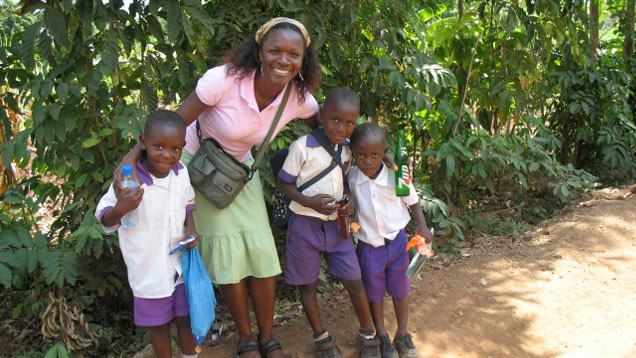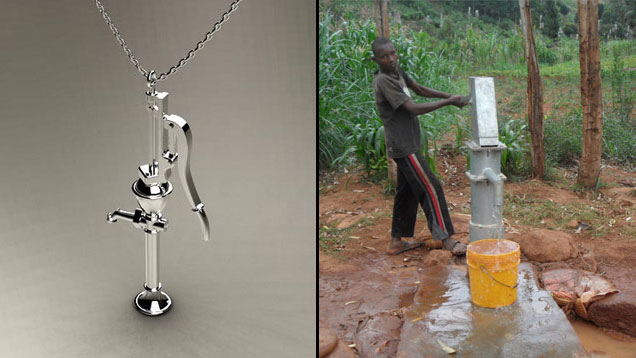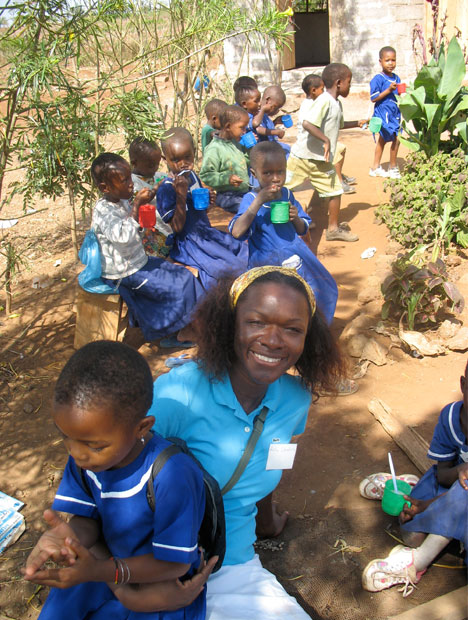Gemologist Sets Her Sights on Social Justice, Healthy Business
June 25, 2014

But this pendant is no mere accessory: it symbolizes one gemologist’s vision to revolutionize the jewelry industry by recognizing people as its “most precious resource.”
Alethe Fatherley, executive director of Jewelers for Water, hasn’t always tried to link social justice with the jewelry industry – in fact, the idea of encouraging an industry that’s both responsible and profitable has only crystallized for the East Coast-based gemologist in the last several years.

Jewelers for Water’s sterling silver necklace, left, designed by Thomas Kurilla and manufactured by Hoover & Strong, was inspired by a water pump, right. Sold by local, brick-and-mortar jewelry stores on the East Coast, proceeds from sales of the necklace benefit Jewelers for Water’s clean water projects. Photo by Thomas Kurilla, courtesy Jewelers for Water
The daughter of Jamaican immigrants, Fatherley moved to the United States when she was 8 years old. She was deciding on her next step after she graduated from high school in 1991, when her godmother, a buyer in Tiffany & Co.’s Paloma Picasso department, suggested she apply at the New York headquarters.The eager-to-learn 19-year-old was hired for a temporary clerical job with Tiffany’s, and shortly after landed a merchandise assistant position in the firm’s diamond-buying office.
“I knew I wanted more than an entry-level position,” she says. “I also became more interested in learning about diamonds, because the Tiffany’s sales professionals had very high expectations, even for a teenager.”
The salespeople often quizzed their new hire, holding up GIA diamond grading reports and asking Fatherley to explain them and describe the stone’s clarity characteristics. “When I wasn’t able to, I could hear the frustration in their voices,” she says. “So I began to insist I attend GIA with almost every evaluation I had with my boss. I just kept asking.”
Fatherley’s persistence paid off; she was eventually cleared to study at the Institute’s 47th Street campus in New York City.
“I loved it ‒ finally, I felt like I was doing something I really enjoyed,” she says. “I still recall the bounce in my step after GIA, just embracing my walk down Fifth Avenue.”
Fatherley earned her GG diploma in 1999, but she knew it was just the beginning if she wanted a career that lasted. She joined the GIA Alumni Association and set out to learn sales, marketing, wholesale – and, after a 13-year career there, the industry outside of Tiffany & Co.’s walls.
She taught gemology at New York’s Fashion Institute of Technology, and worked for David Yurman, H. Stern, and Lazare Kaplan International, where she sold loose stones. At Lazare Kaplan, conversations often referred to the firm’s cutting facilities in Namibia.
“I became interested in Africa and simply wanted to learn more about the people,” she says.
That desire to learn more soon turned into something much deeper. Fatherley researched nonprofit organizations and settled on Cross Cultural Solutions, a non-governmental organization. Her supervisor at Lazare Kaplan granted her a three-week leave from work, allowing Fatherley to travel to Moshi Town, Tanzania and serve as a kindergarten teacher at Kilimahewa school. The makeshift classroom where she taught was set up in the home of a pupil’s parents.
The stark contrast between the world of luxury jewelry and the lives of people in Tanzania moved her deeply, and quickly. Fatherley returned home just weeks later with an entirely new perspective, and founded Jewelers that Care in 2009. The goal of her nonprofit is to “energize development projects,” such as schools and water wells, through donations and partnerships with other aid groups. (The organization’s name changed to the more focused Jewelers for Water this spring).

Alethe Fatherley took a three-week leave from her job with Lazare Kaplan International
to teach kindergarteners at Kilimahewa school in Moshi Town, Tanzania. Courtesy Alethe Fatherley
“When we examine the serious issues facing Africa and rural villages around the globe, we find ourselves making a full circle back to the issues of a lack of clean water and education,” she says. “We believe this contributes to the root of other problems, including HIV/AIDS, crimes against women and children, and other serious issues.to teach kindergarteners at Kilimahewa school in Moshi Town, Tanzania. Courtesy Alethe Fatherley
“I wanted to help within my capacity. But the stories of poverty are difficult to tell ‒ and difficult to sell,” she says. “I had to come up with creative ways to get people interested.”
Fatherley - who also earned degrees from the American Gem Society, Fashion Institute of Technology and SUNY’s Empire State college – developed deep relationships in the jewelry industry, and became what she calls “something of a recruiter,” helping friends and colleagues from all aspects of the industry make professional connections in exchange for support of the charity.
Jewelers for Water is focused on building water wells and collaborates with many like-minded professionals in the industry. The water pump necklace, for example, was designed by Thomas Kurilla, manufactured by Hoover & Strong, and is sold exclusively by a handful of local, brick-and-mortar jewelry stores on the East Coast, with proceeds benefitting Jewelers for Water’s water pump projects. The group also created an annual awards ceremony at JCK that honors jewelers addressing humanitarian issues.
Fatherley, who lives in Fairfield, Connecticut with her husband, Christopher, runs Jewelers for Water while caring for the couple’s 4-year-old son, Gordon, and 2-year-old daughter, Marisa.
“My dream and my long-term goal is to collaborate with our industry in the most sensible way that benefits us as an industry, as well as the people living in rural villages,” she says. “I want our industry to shine by contributing to the communities that keep us going.”
About the Author
Jaime Kautsky, a contributing writer, is a GIA Diamonds Graduate and GIA Accredited Jewelry Professional and was an associate editor of The Loupe magazine for several years.
.jpg)


